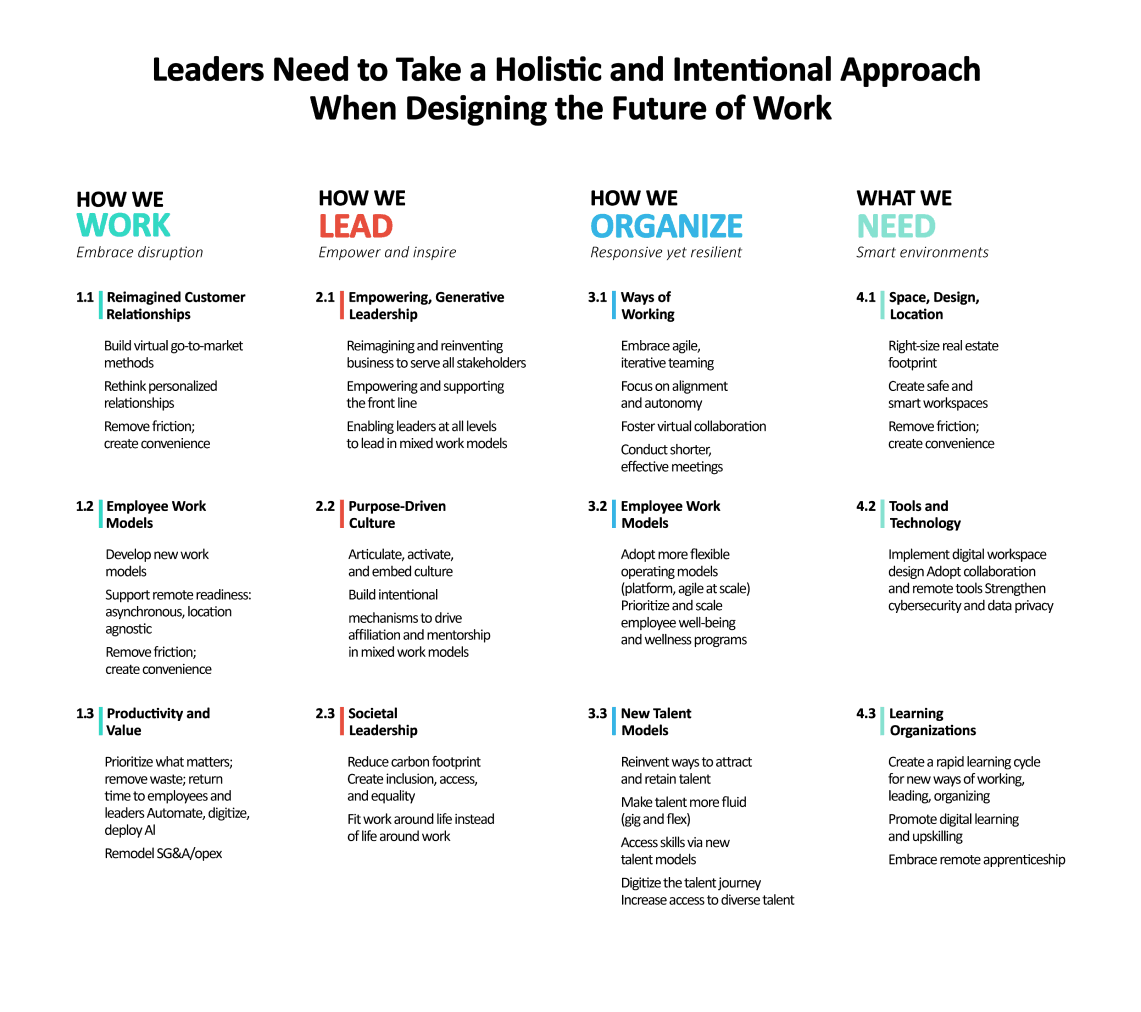Blog
Unpacking the transformed workplace
The global pandemic prompted unprecedented organizational change, accompanying valuable insights about our productivity, while presenting opportunities for enhanced efficiency.
The changed working environment prompted leadership teams to re-examine the structure of their organizations. This reflection can offer a definitive roadmap towards stronger connections, improved workflow, and new innovations.
Amidst the evolving competitive landscape, Tech Unicorn has developed an integrated approach that gives organizations a competitive advantage. The future of work does not include a one-size-fits-all model. Instead, leaders and their teams need to design their own modus operandi intentionally, holistically, and thoughtfully. We recommend examining four critical areas: how we work, how we lead, how we organize, and what we need. (See exhibit)

How we work: an adapted approach to the workplace
Embracing the organizational changes that were caused by the pandemic offers a new, revised set of work practices. This approach prompts us to reassess consumer needs, adapt our existing work models, and introduce systems for increased productivity.
Consumer relations reimagined The consumer remains the central component to the future of work. To remain relevant and competitive, companies should reconsider how the consumer’s needs have changed and how their engagement channels are impacted. The digital brand home has shifted into a new gear, for example, as consumers are increasingly engaging in online experiences. Therefore, companies should consider how all pandemic-driven innovations may have accommodated customers, and how these structures can be improved.
New employee work models
Your selected work model should allow flexibility, collaboration, and productivity. We recommend four key considerations when designing your differentiated work model:
- Include both company ideals and business objectives
- Incorporate employee preferences
- Equip teams with the knowledge, new skills, and tools needed to develop
- Account for diversity, equity, and inclusion
How we lead: empowering the workforce
The significantly changed work environment, calls leaders to truly transform: to be generative, purpose-driven, and to ensure that their enterprises are aligned with prominent social issues.
Empowering, generative leadership
A generative approach to leaderships means working across all locations towards the needs of their employees, customers, communities, and planet, while delivering profit for shareholders. Leaders should ensure that every touchpoint serves as a positive interactive with the enterprise. This requires a strong focus on building cohesion and coaching new skills and integrating employee trust.
Purpose-driven culture
Companies should identify their unique purpose and should base all actions upon this foundation. This unique purpose should be embedded in strategic decisions and should guide all day-to-day interactions. This leads to the creation of a strong company culture - a key differentiator in both the commercial and talent marketplaces.
Societal leadership
We have become acutely aware of the impact that our actions have on global issues. Our responsibility, therefore, extends to more than our employees and shareholders. Every organization must discern how their action may be contributing to greater societal issues.
How We Organize: operations rewired
Our operating models will need to be reassessed and rewired to lock in the necessary changes. This involves transforming our internal processes, organizational structure, and talent models.
New ways of working
One of the best changes that resulted from the pandemic is that teams came together across siloes to work on the most important priorities. This resulted in priority-driven, cross functional, streamlined operations.
Agile organizations
Transitioning to agile-at-scale organization models will allow these streamlined, efficient, and cross-functional innovations to become more enduring. This means reinventing the structure and culture of how we work. The pandemic also had a positive impact on how organizations care for their employees, through the creation structures that account for mental well-being, health, safety, and future opportunities.
New talent structures
The pandemic presented a great opportunity for employees to search beyond their immediate geographic location for work opportunities that meet their needs. Companies that embrace location-agnostic hiring policies will benefit from higher quality and more diverse candidates. In addition, there are multiple tech platforms that can help enable this talent fluidity within organizations, with AI-based skills tracking allowing managers to identify opportunities for contribution.
What We Need
To enable these new ways of working, companies need to transform their physical workplaces, by investing in new tools that support the development of skills.
Purpose-driven design
The pandemic revealed opportunities to reinvent the workplace to ensure that it facilitates connection, affiliation, and learning. The ability of to deliver these functional outcomes becomes the new criteria to evaluate its success. This means that the office should include spaces, signage, and designs that help employees to understand their purpose.
Tools and tech
Companies should introduce shared booking tools, for on-site, hybrid and remote collaboration. These booking tools offer important data on workforce functionality and operations, allowing the company to understand how platforms are being utilized and how tools can be improved to facilitate teamwork. Companies need to take an intentional approach, ensuring that the booking systems encourage social connection, on-site affiliation, as well as learning opportunities.
Learning organizations
Learning should be completely embedded in the flow of daily work, giving every moment the prospect for innovation. Teams should collectively reflect on processes that enabling creativity while identifying systems that may be inhibiting their growth. Rotating talent, through flexible talent models, will also drive opportunities for daily learning.
Final thoughts
The pandemic sparked a wave of ingenuity that has led to a revised approach to the workplace. Companies need to embrace flexibility, by continually reassessing their business models to implement changes when needed. These changes should be informed by the needs of their consumers, as well as the work preferences of their employees. This can be attained by ensuring that teams are equipped with the tools, knowledge, and environment to enhance their final outputs.